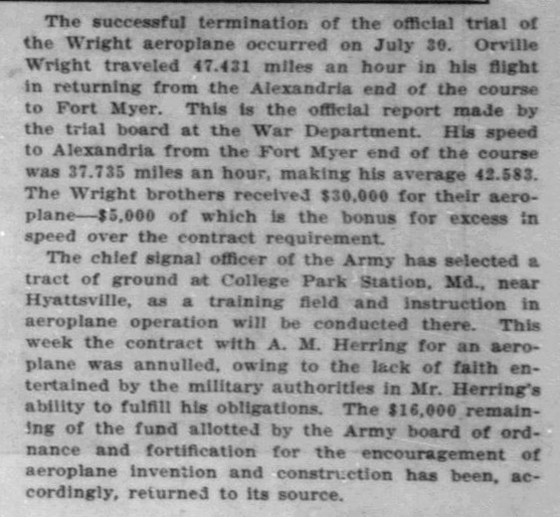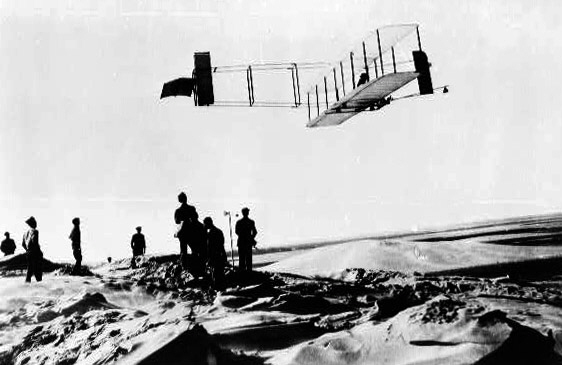First Flight
On the morning of December 17, 1903, Wilbur and Orville Wright took turns piloting and monitoring their flying machine in Kill Devil Hills, North Carolina. Orville piloted the first flight that lasted just 12 seconds and 120 feet. On the fourth and final flight of the day, Wilbur traveled 852 feet, remaining airborne for 59 seconds. That morning, the brothers became the first people to demonstrate sustained flight of a heavier-than-air machine under the complete control of the pilot.
They built their 1903 glider in sections in the back room of their Dayton, Ohio, bicycle shop. That afternoon, the Wright brothers walked the four miles to Kitty Hawk and sent a telegram to their father, Bishop Milton Wright, back home in Dayton:
In 1900, Wilbur Wright wrote to his father expressing the hope of “achieving fame and fortune” from his and brother Orville’s experiments in flight. Three years later, the brothers accomplished their first successful flight. As part of their systematic practice of photographing every prototype and test of their various flying machines, the Wrights persuaded an attendant from a nearby lifesaving station to snap Orville in full flight. After making three longer flights that day, the Wrights sent this telegram to their father, instructing him to “inform press.” In his diary, seen here, Orville kept a thorough account of their experiments. This entry details their second successful flight.
Orville and Wilbur Wright requested a patent application for a “flying machine” nine months before their successful flight in December 1903, which Orville recorded in his diary. The craft soared to an altitude of 10 feet, traveled 120 feet, and landed 12 seconds after takeoff. After making two longer flights that day, the Wrights sent this telegram to their father, instructing him to “inform press.”

Design Features:
The 1903 Wright Flyer was constructed of spruce and ash covered with muslin. The framework “floated” within fabric pockets sewn inside, making the muslin covering an integral part of the structure. This ingenious feature made the aircraft light, strong, and flexible. The 1903 Flyer was powered by a simple four-cylinder engine of the Wrights’ own design.
To fly the airplane, the pilot lay prone with his head forward, his left hand operating the elevator control. Lateral control was achieved by warping the wing tips in opposite directions via wires attached to a hip cradle mounted on the lower wing. The pilot shifted his hips from side to side to operate the mechanism, which also moved the rudder.
Wingspan:…………………. 12.3 m (40 ft 4 in)
Length:…………………….. 6.4 m (21 ft)
Height:…………………….. 2.8 m (9 ft 3 in)
Weight, empty:…………… 274 kg (605 lb)
Engine: Gasoline,…………. 12 hp
Manufacturer:…………….. Wilbur and Orville Wright, Dayton, Ohio, 1903
December 1903
By June 1903, Orville and Wilbur Wright had finished designing and building their powered machine. The Flyer had a wingspan of a little more than 40 feet (12 meters), a surface area of 510 square feet (47 square meters), and weighed 625 pounds (283 kilograms). They constructed as much of the Flyer as they could in Dayton, Ohio; then shipped the parts to Kitty Hawk for final assembly .
The brothers left for Kitty Hawk on September 23 and arrived at their camp at Kill Devil Hill two days later. While they waited for their shipment to arrive, they repaired the old hangar and built a new workshop. After the shipment arrived, it took the Wrights three weeks to assemble the Flyer. While they were doing this, they continued to practice gliding using their 1902 glider , gliding for longer times and increasing their ability to control the craft.
The weather was horridâ€â€cold and stormy. Nevertheless, they worked on and finished assembling the Flyer in early November. On November 5, they tested the motor. The results were not good. The engine ran roughly and did not work as expected. Its excessive vibrations damaged the propeller shafts, which had to be sent back to Dayton for repair. In Dayton, Charlie Taylor, their machinist, rebuilt them and shipped them back to Kitty Hawk. They arrived two weeks later.
They tested the engine again on November 28. Once more they had problems with a cracked propeller shaft. This time, Orville went back to Dayton to make new propeller shafts of solid spring steel. It was December 11 before he returned to camp.
By this time, they had lost a lot of time with repairs and were far behind their schedule. They decided to forget about testing the Flyer as an unpowered glider. They would begin testing it with its engine immediately.
The Flyer was ready for flight on December 12, but the winds were too light to take off. They did not attempt a flight on Sunday, since they had promised their father they would not fly on the Sabbath. Their first attempt at powered flight would take place Monday, December 14.
With the help of the Kill Devil Hills Life Saving Crew, they hauled the machine up the slope to where it would take off. They tossed a coin to see who would fly. Wilbur won, climbed aboard the Flyer, and lay prone on it. After a somewhat difficult start, the craft began to move down its rails and then rose from its track. But Wilbur had miscalculated and had turned upward too soon, not realizing the effectiveness of the elevator. The Flyer climbed a few feet, stalled, and then settled onto the ground near the foot of the hill. The machine was damaged slightly. Nevertheless, it had left the ground under its own steamâ€â€a promising start. Both Wilbur and Orville were sure that the machine would fly
Repairs took two days, and the machine was ready again late on December 16. December 17 dawned with a strong wind blowing from the north and rain beating down. The rain stopped, but the wind kept blowing. Wilbur estimated that it was at least 25 miles per hour (40 kilometers per hour). The brothers waited until after 10 AM, hoping that the wind would die down a little. When it did not, they decided to go ahead anyway. They sent a signal to the men from the Life Saving Station to come and help them haul the Flyer to their staging area up the hill.
It was Orville’s turn to fly, and he climbed aboard the Flyer. The Flyer was released from its restraining wires and began to move down the rail into the wind. It rose quicklyâ€â€again they had underestimated the effectiveness of the elevator. The machine pitched up and down for 12 momentous seconds and then landedâ€â€with the machine and the pilot intact except for one damaged skid. It had flown 120 feet (36.6 meters) from the end of the rail. For the first time, a powered flying machine had taken off from level ground, traveled through the air, and landed under the control of its pilot.
Not satisfied, the brothers wanted to try again. They repaired the cracked skid, and at about 11:20 AM, Wilbur made the second flightâ€â€traveling about 175 feet (53 meters).
With the help of the life saving crew, they carried the Flyer back to its starting point and tried again. Twenty minutes later, Orville made the third flight and landed about 200 feet (61 meters) from his starting point.
The fourth flight took off around noon with Wilbur at the controls. The flight began like the othersâ€â€with the Flyer pitching upward and down. After about 300 feet (91 meters), Wilbur got it under control and began traveling on a fairly even course. He proceeded this way until he was around 800 feet (244 meters) out. Then the Flyer began bucking again and suddenly plunged into the ground. The front rudder frame was badly broken, but the main frame was intact. It had traveled 852 feet (260 meters) in 59 seconds.

As the men were carrying the plane back to its starting point. ready for another try. a sudden gust of wind grabbed one wing and lifted it up. One of the life saving crew, John T. Daniels, tried to seize the spars, but could not. The machine turned over on him. Fortunately, he was not seriously hurt, but the plane was destroyed. It had accomplished a milestone, but would never fly again. The brothers would ship the remains home to Dayton.
After lunch, the Wrights telegraphed their father with their news. “Success four flights thursday morning # all against twenty one mile wind started from Level with engine power alone # average speed through air thirty one miles longest 57 [sic] seconds inform Press home ####Christmas

Telegram, Orville Wright to Bishop Milton Wright announcing the first successful powered flight 17 December [1903]. (Wright Brothers Papers)

Wilbur and Orville Wright with their Second Powered Machine, Huffman Prairie, Dayton Ohio, May 1904.

The U.S. Army saw potential in the new technology and signed a contract with the Wright brothers in 1908. Their new Military Flyer was successfully tested in 1909.



Orville Wright made another record soaring flight of 9 3/4 minutes October 24, 1911 in Kitty Hawk, North Carolina


Wright brothers
Wright brothers, American airplane inventors and aviation pioneers. Orville Wright 1871-1948, was born in Dayton, Ohio, and Wilbur Wright, 1867-1912, near New Castle, Ind. Their interest in aviation was aroused in the 1890s by the German engineer Otto Lilienthal’s glider flights. Both excellent mechanics, the Wrights used the facilities of the bicycle repair shop and factory which they operated (1892-1904) at Dayton for the construction of their early aircraft. By experimenting with movable portions of the wing assembly, rather than shifts in bodily weight, as a means of correcting the aircraft’s position in flight they made an important improvement in aircraft design. During this period they drew up valuable tables of wind pressure and drift. Orville designed an engine, which they constructed and attached to their improved glider.
On Dec. 17, 1903, they made near Kitty Hawk, N.C., the first controlled, sustained flights in a power-driven airplane. Of their four flights on that day, the first, made by Orville, lasted 12 sec, and the fourth, by Wilbur, covered 852 ft (259 m) in 59 sec. The brothers continued their experiments at Dayton and built several biplanes. Record-breaking flights in 1908 by Orville in the United States and by Wilbur in France brought them worldwide fame. In 1909 the U.S. government accepted the Wright machine for army use, and the brothers established the Wright Company. The house where Orville was born and the bicycle-shop laboratory have been restored and were moved to Greenfield Village, Mich.
Wright Brothers Day
Wright Brothers Day commemorates the first successful flight in a heavier than air, mechanically propelled airplane. Orville and Wilbur Wright made the flight on December 17, 1903, near Kitty Hawk, North Carolina. The U.S. Congress designated December 17 of each year as Wright Brothers Day.
The papers of Wilbur (1867-1912) and Orville (1871-1948) Wright were given to the Library in 1949 by the executors of Orville Wright’s estate. Over the years the Library has received additional materials through gifts and transfers, and altogether the collection comprises diaries and notebooks, family papers, general correspondence, subject files, scrapbooks, and over 1,100 photographic images, including 300 original glass plate negatives. http://memory.loc.gov/ammem/wrighthtml/wrighthome.html also see http://www.centennialofflight.gov
